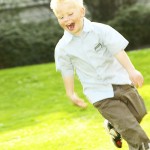 A new study reported in The Journal of Pediatrics, reports that exercise may benefit children with ADHD. In this study, kids with ADHD were matched with a same-age, same-socio-economic status group of “normal” children. The groups engaged in two experimental conditions: one day then engaged in 20 minutes of quiet reading, and the next day they did 20 minutes of treadmill exercise.
A new study reported in The Journal of Pediatrics, reports that exercise may benefit children with ADHD. In this study, kids with ADHD were matched with a same-age, same-socio-economic status group of “normal” children. The groups engaged in two experimental conditions: one day then engaged in 20 minutes of quiet reading, and the next day they did 20 minutes of treadmill exercise.
After each condition, children took reading and math tests, and a test designed to pinpoint distractibility and the ability to focus on a task. Both groups did better after exercise than they did after 20 minutes of quiet reading. Another study, this one in The Journal of Attention Disorders, indicated that students with ADHD had better behavior reports from parents and teachers after a 10-week physical activity program, compared to a matched group of ADHD students who didn’t engage in the program.
These studies underscore the importance of giving students who have been diagnosed as having ADHD, ample opportunity to engage in physical exercise before, during, and after academic learning activities. Here are some tips for teachers :
* Before a test, have students do 30 seconds of jumping jacks, 30 seconds of stretching their arms high above their heads, and 30 seconds of “windmill” activity (making their arms move like a windmill).
* To learn spelling words, have students spell them out loud while sitting down on each consonant and standing up on each vowel.
* If students are especially jumpy, have them run around the school building once or twice before sitting down in their seats.
* Teach students ”progressive relaxation” where they progressively tense and relax different parts of their body, starting with the feet and ending with the face.
* Encourage students with ADHD to try out for an extracurricular sport (research indicates that individual sports like tennis or gymnastics often work better than competitive sports like soccer or football), or suggest that they engage in martial arts training at a local community center.
I remember in the 1980’s when the American Academy of Pediatrics put out a position paper which stated that before a trial of Ritalin is used with a child, there should be, among other things, ”a strong physical education program’ put in place at that child’s school.’ Sadly, this is no longer part of the official view of the Academy. Yet research on ADHD from Purdue University has long indicated that children with ADHD are ”understimulated” and need higher doses of activity than the average student. By giving them more physical exercise, we can make it more likely that they will experience success in the classroom.
For more information on non-drug alternatives to ADHD, see my book The Myth of the ADHD Child, Revised Edition: 101 Ways to Improve Your Child’s Behavior and Attention Span Without Drugs, Labels, or Coercion
This article was brought to you by Thomas Armstrong, Ph.D. and www.institute4learning.com.
Follow me on Twitter: @Dr_Armstrong



















